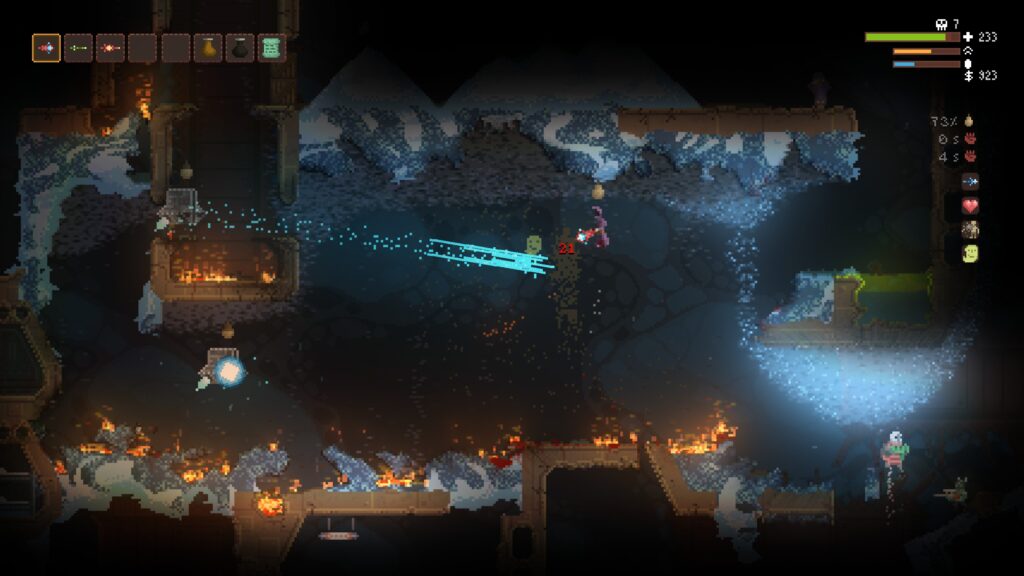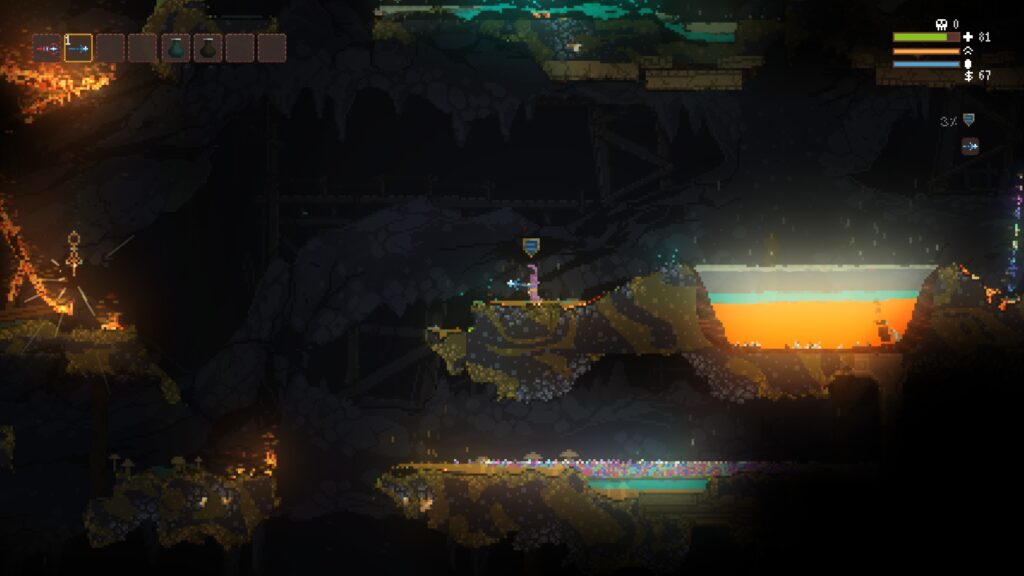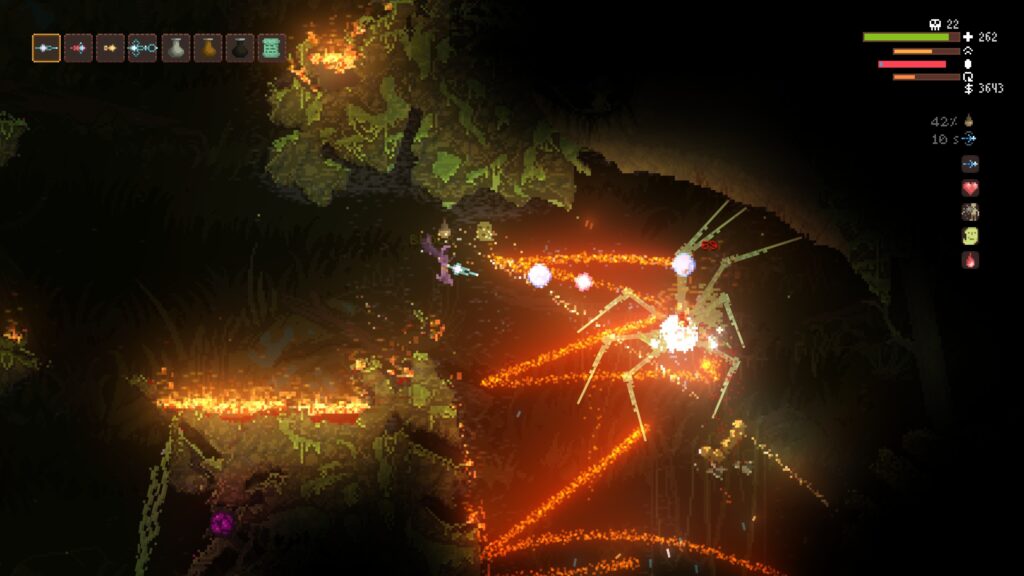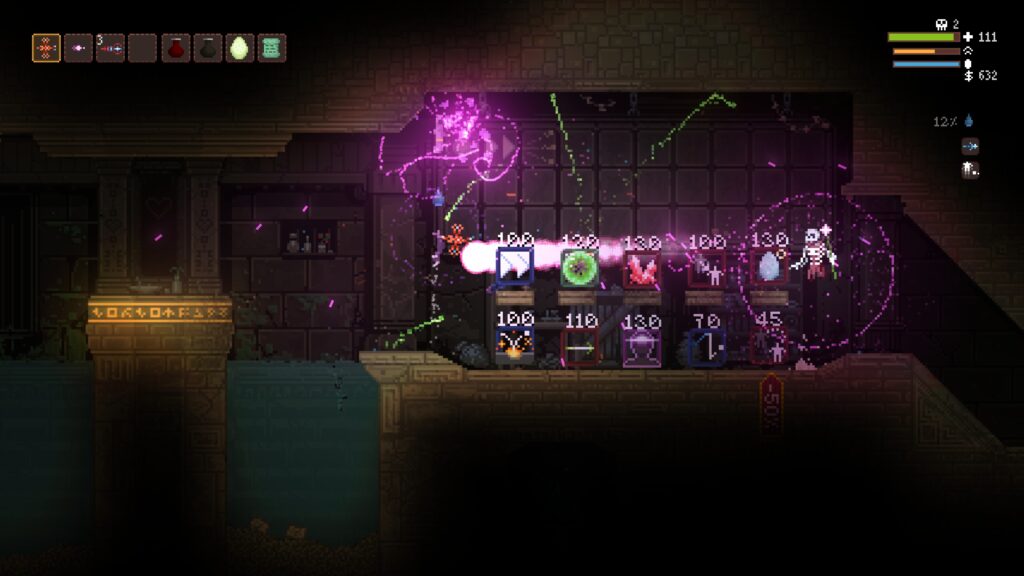I’m terrible at platform games and terrible at roguelikes and this is both! I wanted to give this a go anyway due to its very interesting gameplay mechanics. It doesn’t look like much with old-school pixel graphics but that’s actually part of what makes it so special. Every pixel of the game world is physically simulated and so everything is potentially destructible with the right effects! The problem is that the environment becomes incredibly chaotic and combined with how little healing is available in-game, it’s a very difficult game. I ended up using a mod to give myself extra revives after dying just so that I could actually see more of the game.
New players are thrown right into the gameplay without any explanation of the setting or instructions. You’re apparently a mage of some sort who is able to cast spells out of a wand. Your explorations will naturally lead you into a cave which opens up into a series of mining tunnels and caverns. There you’ll have to fight enemies which seem to be named after creatures from Finnish mythology. At the very bottom of the area are portals which will take you to a safe zone called the Holy Mountain. There you’ll be able to heal, pick a perk as an upgrade and buy wands or spells. Then it’s off to the next biome to do the same thing all over again. Here and there you’ll find clues like tablets which hint at the background lore but it doesn’t seem like there’s much more story than that. There are many secret areas to discover and it seems that the world is actually quite a bit larger than what is immediately apparent.
Everyone has played games with destructible objects in the environment of course, exploding barrels, traps of all kinds, floors that can break and so on. Noita takes this to a different level entirely as every pixel can be interacted with. Every pixel is made of some substance and so has inherent properties. Rock for example is hard and therefore difficult to destroy. Sand makes for a solid surface but can still flow around. Liquid flows and pools at the lowest point it can reach. Wood can burn and so on. Add to that the seemingly tons of spell effects that are in the game and you get endless possible combinations. Even the toughest material can be destroyed with enough patience or the right spell. In fact, often enemies on the level die without you having to do anything because of some chaotic cascade of events, usually beginning with one of them setting something on fire. Every time I thought I’d seen everything, the game continues to surprise me. For example at one point I found a row of potion bottles in an area. But before I could collect them, they were set on fire, everything poured out onto the ground. I can’t even begin to understand the complex series of interactions that resulted but they were certainly colorful!
Another of the game’s innovations is that the wands can be edited. All spells are cast out of wands and every wand has at least one spell loaded. When you arrive at a Holy Mountain however, you can edit what is loaded into a wand, taking out and putting in effects as you wish. Wands differ in terms of their firing rate, recharge rate, mana and how many spells each can hold. In lieu of spells, you can also load them with modifiers which alter how many spells are shot at a time, their speed, spread and much more. Once again, the possibilities are endless. With a good, fast-firing wand, it’s possible to fill the screen with all kinds of projectiles, bullet-hell style. As so many objects in the environment can be set on fire and destroyed, you can imagine the amount the sheer devastation that is possible. When you do manage to build such a wand, it’s incredibly fun to let loose and watch the enemies melt.
Unfortunately you don’t get the same power and variety in defensive options. It’s true that some perks are insanely overpowered. Nothing is more satisfying than setting the whole level on fire when you have fire immunity. But which perks appear is random and a lot are just crappy. You get one guaranteed full heal at the end of every biome and almost nothing in between. This means that health is incredibly precious as this is a true roguelike which forces you to restart from beginning if you die. It is possible to get good at this game. You have to advance very cautiously to avoid triggering enemies. You have to be constantly aware of the environment and be familiar with all of the enemy types. More knowledge helps you build better wands and so on. But it’s still really, really hard. In a game in which every pixel is simulated, every pixel matters. A floating pixel in the wrong place could block you from dodging to safety. A single, chaotic interaction could cause instant death. It calls for a very high level of persistence and caution, too much for me in fact.
I eventually resorted to a mod to give myself revives just so that I could see more of the game. As you might expect, the later enemies are much more powerful and aggressive, being willing to chase you down through tunnels and platforms. Some are able to target and hit you from a long way away. Others are so tough that you’d need a lot more firepower to take them down. Most of all, I’m aware that there is so much more to this game that I’ve yet to discover including all of the bosses. But reaching that point would require endless hours of dying over and over again. That’s just too much of a commitment for me. The designers are purists enough not to include any difficulty options and using mods will invalidate Steam achievements. I’ve seen even veteran players complain that the early game is an unnecessary gamer tax as the more powerful, and hence fun, options only come much later.
If I’d spent more time earlier in my life with platform games and roguelikes, I might have more of a base to develop the skills to properly tackle this game. But I don’t and cheating with the mods feels empty really quick so I’ll have to drop this. I do really admire the design. Simulating every particle in a game world isn’t new but this is a clever way to get meaningful gameplay out of it. I also note that it can be quite a resource intensive game. It turns out that simulating everything takes a lot of calculations. I had a couple of serious slowdowns even though I’ve touched only a tiny fraction of what the game offers. I can totally believe the claims that the tons and tons of particles endgame wands can throw out can drive a computer to its knees.



